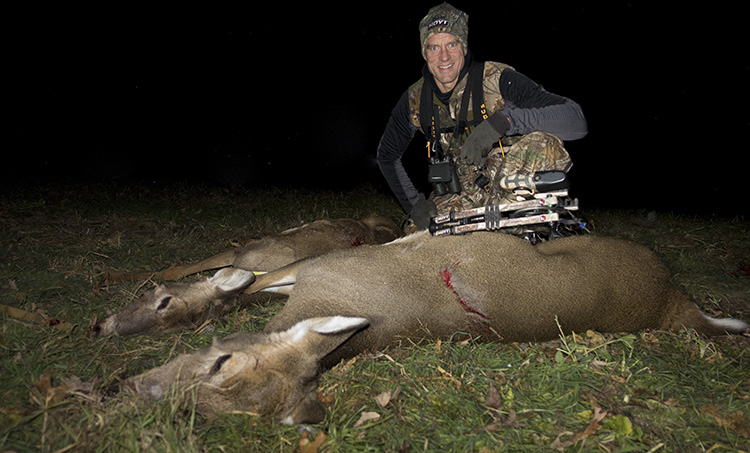Rob from Tennessee asks,
Hi Bill, I heard one of your strategies on your old farm was to kill does and bring the buck to doe ration down to more acceptable level. You commented that it took 4 years to do it? How did you do it and did you have to get a nuisance permit? I have a farm in Southern IL that has the same problem and they are eating the row crop beans. Could you tell me more about that?
Bill responds,
Topic: Leveling the Buck to Doe Ratio:

For a period of roughly four years, myself and my friends shot every doe that passed within bow range. The result was a fast change in the structure of the deer herd.
Rob,
Readers should keep in mind that this advice is not for every situation – only for areas with a high deer density.
It took a very determined commitment and help from friends and neighbors to get that done. At that time, I had a friend named Mike Sawyer who often hunted with me. He loved shooting bucks, but he also loved shooting does nearly as much. I asked him to shoot every doe that came within bow range while he was at the farm. I think he killed 12 one season. I did the same thing. I would look at any doe approaching to see if there was a shooter buck immediately behind her. If not, I would do everything in my power to shoot her.
I also had a couple of neighbors who I could trust to only shoot does. They had groups that hunted with them and I let them go through the farm one year. They shot 12 or 15, if I remember right. I also had a friend who wanted to bring his rifle over during Iowa’s late rifle season that year (in southern Iowa the DNR permitted a late season rifle hunt to encourage additional doe killing). That fellow shot a whole trailer full of them in one day sitting on a high ridge overlooking an isolated soybean plot. There had to have been 10 in that pile. I also shot a half dozen during the late muzzleloader season.
All in all, I think we took about 65 does that year. That was the first year of real effort to get things under control. After that, the herd looked much different, but I still kept shooting all the does that came past me (and so did Mike) for a couple more years.
That was in the mid-2000s. Iowa had just opened up a program where you could get lots of does tags for $10 each. So, I didn’t use nuisance or depredation permits to shoot the deer. We shot them all during the regular seasons.
Bottomline is that you can’t take modest measures and expect this to work. You have to really make a big commitment to shooting every possible doe at first and then you can taper off after that. Biologists say that you have to shoot roughly 30% of the adult deer each year in good ranges (like my Iowa farm) to keep the herd from growing. So if you want to bring it down you have shoot well over 30%. That is a huge task and one that requires help and determination.
In the end, we overshot a level buck to doe ratio. For several years (probably four years) after I stopped shooting every doe that came past, my buck to doe ratio was heavily skewed toward bucks. I had way more bucks than does on that farm. More about that another time, but it was really something to hunt a farm for a few years where there were roughly 3 bucks for every doe!
It is a lot of work, but if you hit it hard you can make a big difference in just a short time. Good luck. (7/23/22)

Hi Bill
Great to see you posting more content again, here and YouTube!
I’m curious on this subject, especially as we’re considering the same application on our farm. Can you elaborate more on how the hunting was as a result…new bucks moving in, better genetics post doe harvest, better rut hunting (bucks moving more in daylight searching for does/etc), other impacts?
I know this would take a ton of work and help, as you mentioned, so we’re considering that compared to other theories which allude to the idea of shooting “a lot” of does doesn’t really do much because the herd is based on carrying capacity of the land regardless of how many you shoot. So, if you shoot a ton of does, your farm will act as a vacuum and other does will just move right back in. Curious what you think?
Thanks!
Jake, Thanks for the support. The main difference in behavior was more buck movement during the rut. I didn’t feel that many of the bucks on my farm left to look for does elsewhere. I believe they only know what is in their normal range. It is not as if they know there are more does in other areas unless that is already part of their range.
I do think that it will work better if your neighbors are doing it too – at least making an effort. My neighbors were shooting more does than normal during that stage, but not nearly as many (or as aggressively) as on my farm. I think the vacuum theory does have some merit, but does are less likely to change their core areas than bucks so the vacuum is more likely to fill with a higher ratio of bucks than does. Like I said, my immediate neighbors were also shooting does so I am not sure what would happen if I was the only one. I would have still done it, but I am guessing it would have taken longer than just a couple of years to make a long term difference. Good luck. (7/24/22)